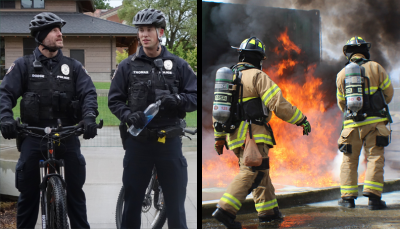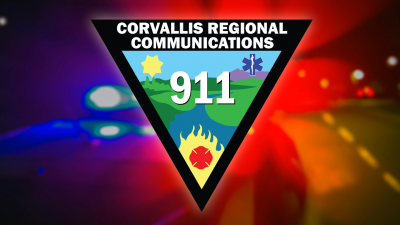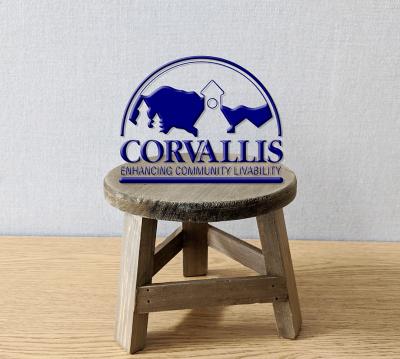The Three-Legged Stool: A Funding Model for the Future
The "three-legged stool" is the current sustainable revenue model that funds key City operations in Corvallis, including services in the Police, Fire, Library, and Parks and Recreation departments. Each leg of the stool (described in more detail below) supports one aspect of City services, and each leg uses a different method for raising revenue and balancing community needs.
The "stool" was first conceptualized in late 2018, as the City Council was considering a renewal of its five-year local operating levy. A prior work effort (the Sustainable Budget Task Force of 2015-2016) had identified significant unmet needs across the entire organization — far more than what could be satisfied through a typical five-year voter-approved levy, particularly as long-term trends continued to show increasing costs for service alongside declining revenue from traditional sources such as property taxes. These problems were compounded by the fact that several of the community's largest employers are nonprofit organizations and do not contribute to city funding through property taxes.
In spite of these challenges, the City undertook significant cost-saving measures in 2016, ultimately cutting $1.2 million over two budget cycles as a proactive measure to "tighten its belt" — before seeking more revenue from the community.
After a robust public process throughout much of 2017 and 2018, the three-legged stool model was identified as the best option to spread the financial need across three different components, enabling the City to avoid a large property tax levy while also encouraging a financial contribution from its nonprofit community employers. The legs of the stool are described in detail below.

Leg 1: Local Option Levy for Library and Parks & Recreation
The first leg of the stool was a reorganized five-year local option levy that was presented to voters in May 2019. Feedback on previous efforts had revealed that the community was most likely to support a tax levy that focused exclusively on "livability" services for the Library and Parks and Recreation departments. The levy was reorganized so that community members could clearly understand what services were at stake and how their tax money would be spent throughout the five-year duration of the levy. Perhaps most critically, because an existing bond measure was expiring, the May 2019 levy did not represent an increase in property taxes.
The five-year local option levy was approved by voters in May 2019 by a margin of nearly 73%. The Corvallis community will have an opportunity to consider a renewal before the levy expires in 2024.

Leg 2: Public Safety Fees for Police and Fire Services
The second leg of the stool was developed in parallel to the levy. While the voter-approved levy was intended to support Library and Parks & Recreation services, the City Council was also interested in finding a way to provide additional funding to the Police and Fire departments, both of which have been underfunded and understaffed for years (compared to similar cities in Oregon). With an increasing focus on disaster preparedness and resilience, the Council responded to the community's requests to prioritize a new, dedicated revenue stream to increase the services provided by the Police and Fire Departments.
To tackle this challenge, the Council decided to create and implement two public safety fees on customers' monthly City Services bills, totaling about $17 per month for a typical single-family household. Together, these two fees will raise about $4.4 million annually, with the Fire service fee projected to raise about $1.3 million each year and the Police service fee projected to raise about $3.1 million each year. The fees were voted into law in December 2018 and went into effect on July 1, 2019. At the Council's direction, the fees were reduced by about $4 per month following the approval of the new 9-1-1 service district (see Leg 3 below) to offset the cost for Corvallis residents.
Placing the fees on the monthly City Services bill ensures that a broad spectrum of the Corvallis community will contribute to Police and Fire support, including large nonprofit employers, making the fees as equitable as possible to the largest number of people in the community. In addition, the fees can be adjusted as Corvallis continues to grow and respond to new challenges in the future.

Leg 3: 9-1-1 Service District in Benton County
The third leg of the stool was an initiative in 2019 to replace the outdated intergovernmental agreement for 9-1-1 emergency dispatch services in Benton County. The existing agreement dated back to 1983 and had remained largely unchanged even as Benton County had grown and changed over the last 35 years. The Corvallis Regional Communications Center (CRCC) provides 911 emergency telecommunications and dispatch services for an area of about 726 square miles, which includes most of Benton County. Over time, the cost of maintaining the 9-1-1 telecommunications system had fallen largely onto the Corvallis Police Department, even though CRCC is made up of 10 partner agencies and municipalities throughout the County.
The goal of the third leg of the three-legged stool was to create a proposal for a voter-approved countywide service district to more equitably share the costs of providing these vital services. The district's tax assessment was set at 65 cents per $1,000 of assessed value, but district officials pledged to levy a reduced amount, about 45 cents per $1,000, for the foreseeable future, to leave room for future growth in the district. Both the City of Corvallis and Benton County worked hard to educate voters about the importance of this ballot measure. In November 2019, the 9-1-1 service district measure passed with about 62% of the vote in Benton County — a resounding endorsement of the plan to modernize the county's emergency communication services.
Toward a More Sustainable Future
Taken together, the three legs of the stool add up to a more stable funding outlook for core City services. Although the makeup of each leg is slightly different, all three have capacity for future growth, which will allow City services to expand as our community grows and changes over time.
